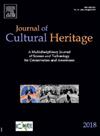那不勒斯Sansevero教堂博物馆祭坛上的蓝色框架中,由Raimondo di Sangro制作的早期人工深蓝色鉴定的多分析方法
IF 3.3
2区 综合性期刊
0 ARCHAEOLOGY
引用次数: 0
摘要
深蓝色是一种从青金石中提取的鲜艳的蓝色颜料,其历史长达数千年。在16至18世纪期间,对深蓝色的需求仍然很高,但它的生产仅限于特定地区,而且非常昂贵。由于它的成本,艺术家很少使用它,有些人选择更便宜的替代品,如蓝铜矿。在19世纪上半叶,化学知识的进步使得人工深蓝色得以生产,然后在整个欧洲传播开来。天然深蓝色和人工深蓝色的鉴别已经成为一个挑战。在这里,我们提出的分析结果表明,在Jean Baptiste Guimet著名的注册发明之前,Raimondo di Sangro (Sansevero王子)生产了人工深蓝色。通过扫描电子能谱仪(sem)和透射电子能谱仪(TEM EDS)对其化学成分进行了详细的研究,并发现了天然色素中常见的辅助矿物的缺失和不常见相的存在,揭示了在Sansevero教堂博物馆(意大利那不勒斯)高祭坛的蓝色框架中发现的颜料的合成来源。此外,反射光谱揭示了颜料主波段的不寻常的变化,将其与天然深蓝色和最近的合成版本区分开来。此外,与以往文献数据的深入对比也加强了我们的实验证据。这些结果为首次生产这种人工蓝色色素开辟了新的视角。本文章由计算机程序翻译,如有差异,请以英文原文为准。
Multi-analytical approach for identification of early artificial ultramarine, made by Raimondo di Sangro, in the blue frame on the altar of the Sansevero Chapel Museum in Naples
The history of ultramarine, a vivid blue pigment derived from lapis lazuli, spans thousands of years. During the 16th to 18th centuries the demand for ultramarine remained high, but its production was limited to specific regions and was extremely expensive. It was used sparingly by artists due to its cost, with some opting for cheaper alternatives such as azurite. In the first half of the 19th century, advancements in chemical knowledge allowed the production of artificial ultramarine, which then spread throughout Europe. The identification of natural versus artificial ultramarine has become a challenge. Here we present analytical results signifying that Raimondo di Sangro (Prince of Sansevero) produced artificial ultramarine before the well-known registered invention by Jean Baptiste Guimet. A detailed study of the chemical composition by SEM-EDS and TEM EDS, along with the absence of accessory minerals commonly found in natural pigment and the presence of uncommon phases, revealed the synthetic origin of the pigment found in the blue frame on the high altar in Sansevero Chapel Museum (Naples, Italy). Moreover, the reflectance spectra disclose an uncommon shift in the main band of the pigment, distinguishing it from both natural ultramarine and more recent synthetic versions. Further, a deep comparison with previous literature data also strengthens our experimental evidence. These results open a new perspective about the first production of this artificial blue pigment.
求助全文
通过发布文献求助,成功后即可免费获取论文全文。
去求助
来源期刊

Journal of Cultural Heritage
综合性期刊-材料科学:综合
CiteScore
6.80
自引率
9.70%
发文量
166
审稿时长
52 days
期刊介绍:
The Journal of Cultural Heritage publishes original papers which comprise previously unpublished data and present innovative methods concerning all aspects of science and technology of cultural heritage as well as interpretation and theoretical issues related to preservation.
 求助内容:
求助内容: 应助结果提醒方式:
应助结果提醒方式:


